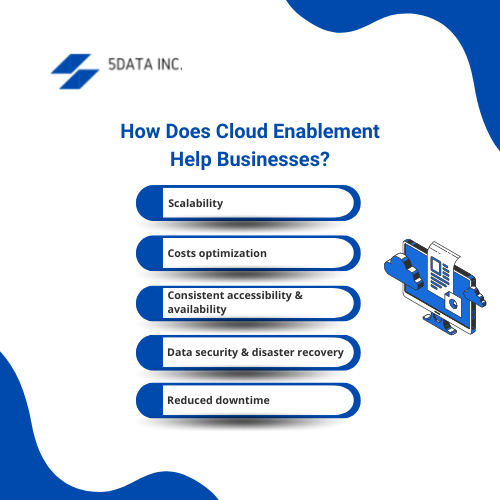However, the capabilities for which the cloud is well-known today emerged during the mid-1990s. Since then, it has rapidly expanded and become a huge game changer. Practically, all businesses now fully or partially use the cloud for their software, infrastructure, data, and resources. Also, with time, it even grew exponentially, leading to the origin of modern digital transformation solutions.
But ever wondered why cloud enablement service is growing in popularity? What advantages does it provide for businesses, and more importantly, do you require it? Let us learn everything from this article.
What Is Cloud Enablement?
Cloud enablement is the process of evaluating a company’s current IT system and designing and constructing an effective cloud environment for enterprises to deploy IT resources.
This procedure typically entails adopting new solutions and migrating the existing applications, current servers, data, desktops, and operating systems to the cloud platform. There are various methods for getting started while using the cloud, such as:
Public Cloud: It is the first choice preferred by most businesses where a third-party cloud service provider (CSP) manages the public cloud. It provides a wide range of choices like infrastructure as a Service (IaaS), Platform as a Service (PaaS), and Software as a Service (SaaS) to manage practically all business requirements.
Private Cloud: If privacy is an issue, a private cloud, which can be hosted on-site or through a cloud provider, is an excellent option. With this service, you get most of the benefits of a public cloud without sharing resources with other businesses, ultimately managing privacy settings.
Hybrid Cloud: It mixes public and private cloud features depending on the company’s requirements and resources. This cloud strategy is frequently used when migrating to certain corporate operations is challenging or when the cost-benefit ratio prevents it from being feasible. 5Data Inc. is a hybrid cloud development company that aims to successfully support businesses in making decisions.

How Cloud Enablement Helps Businesses?
Large-scale businesses can fully leverage successful cloud enablement services because of the following benefits it provides:
- Scalability: Organizations can scale up or down their use of cloud service as necessary. Rather than buying bigger or more potent devices or servers, organizations can adjust the bandwidth of their present apps to accommodate changing business trends.
- Costs optimization: Cloud solutions frequently feature pay-as-you-go business models, requiring users to only pay for their services rather than making significant CAPEX investments in hardware like servers, software licenses, and facilities.
- Consistent accessibility and availability: Virtually any device connected to the internet can access data through a cloud enablement service, and service providers aim for uptime for their products beyond 99.99%.
- Data security and disaster recovery: When data and apps are kept on-site, the security of the physical location affects them. In other words, with built-in backups and servers spread across numerous regions, cloud enablement protects companies from natural disasters and cyberattacks.The best hybrid cloud development company, 5Data Inc., believes that an organization’s core is its data and manages data security by employing proper tools and methods.
- Reduced downtime: Models for cloud migration typically offer low latency services. Because of this, your company can easily get back online if a cloud-enabled resource experiences a system outage. This downtime lessens revenue loss and simplifies defining Recovery Time Objectives (RTO) for cloud services.
How to Successfully Implement Cloud Enablement Strategy?
Here are a few steps for the implementation of a successful cloud management strategy
1.Determine your cloud needs
The first step for a cloud enablement plan implementation is to comprehend the benefits a cloud system will bring to your company. Consider the difficulties you might face as well.
Consider conducting a cloud readiness assessment if you choose to do it yourself or with a managed cloud provider. This assessment will give you a clear idea of what to anticipate and where to begin. It would entail carefully examining your company’s IT setup, apps, and business operations to determine how the cloud can streamline the procedures.
2.Plan your cloud environment
The success of your cloud enablement strategy depends on choosing the right cloud model. Each type of cloud model—private, public, hybrid, and multi-cloud—has advantages and disadvantages. So, you can choose the best cloud solution mix by considering the nature of your operations and addressing compliance and governance requirements. After that, you can plan the cloud architecture and choose a technology solution. Remember to prioritize a phased approach while planning your successful cloud enablement strategy.
The hybrid cloud development company, 5Data Inc., assists in careful planning for cloud management.
3.Select your cloud provider
When you’re ready to switch to the cloud infrastructure, you need to choose the right expertise to assist with the migration. The market is flooded with options, so choosing the right one will be quite difficult and intimidating.
However, the best cloud service provider will possess the required knowledge, technical capabilities, implementing experience, and precise combination of your required cloud-based solutions.
4.Execute the migration
Now comes the actual work, the execution. Our cloud experts at 5Data Inc will guide you through options, develop a roadmap, and allot resources appropriately. Before moving an application or data center to the cloud, create a reliable backup of all the present data.
The next step is to set up the cloud environment using the appropriate devices, networks, and processes. Once the cloud is successfully set up, migrate your data or application there without interfering with ongoing business processes and causing disruption. Finally, test the cloud’s functionality to make sure everything functions as it should.
5.Monitor and maintain
It’s just as crucial to monitor and manage a cloud-based platform as it is to deploy one effectively. You should train your staff to get used to the new platform and successfully manage the change. And to ensure lag-free performance, it’s crucial that you monitor your cloud support, address any problems, and maintain the networks all the time.
How Can 5Data Inc Help?
5Data Inc. is the best software application development company that delivers seamless application development services. We also provide cloud enablement services like the ones listed below:
- Cloud Strategy
- Cloud Native Development
- Hybrid & Private Cloud Development
- Cloud Migration
- Cloud Monitoring & Cost Optimization
So, reach out to our team and get the best cloud enablement strategy from 5Data Inc experts.

Bishnupriya Pradhan
Author
